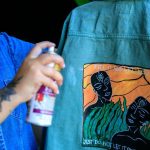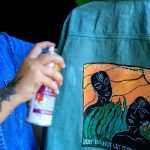When it comes to maintaining fabric protection over time, you need to adopt a proactive approach. Regularly reapplying protective sprays or coatings every 6 to 12 months is essential, especially for items that see heavy use. After any professional cleaning, it's crucial to restore that protective layer without delay. You might notice signs of wear, but understanding how to address these issues effectively can make all the difference. So, what specific strategies should you implement to keep your fabrics looking pristine and lasting longer?
Table of Contents
Key Takeaways
- Reapply fabric protector every 6-12 months, especially for frequently used items, to maintain optimal protection against stains and wear.
- Inspect textiles regularly for signs of wear or loss of vibrancy, indicating the need for reapplication of protective treatments.
- Use eco-friendly cleaning products to prevent damage to fabric fibers and prolong the effectiveness of existing protection.
- Address spills immediately by blotting and using suitable cleaning methods to avoid permanent stains and maintain fabric integrity.
Understanding Fabric Protection
Understanding fabric protection is essential for keeping your textiles looking fresh and lasting longer. It involves applying treatments that shield your fabrics from stains, dirt, and wear. By investing in fabric protection, you're not just enhancing the appearance of your items; you're also prolonging their life.
You can choose various protective options, from sprays to coatings that create a barrier against spills and grime. These treatments work by repelling liquids and preventing them from soaking into the fibers, making it easier to clean up messes before they set in.
When you protect your fabrics, you're also reducing the need for harsh cleaning chemicals, which can damage the fibers over time. This means you can keep your textiles looking good while maintaining their integrity.
It's vital to remember that not all fabrics require the same level of protection. For example, outdoor fabrics may need more robust protection than indoor upholstery. Always check the manufacturer's recommendations for the best approach.
Regular Cleaning Techniques
To keep your fabrics protected and looking their best, regular cleaning techniques are essential in preventing dirt and stains from settling in.
Start by vacuuming your upholstered furniture weekly to remove dust and debris. Use a soft brush attachment to avoid damaging the fabric.
For spills, act quickly! Blot the area gently with a clean, dry cloth—don't rub, as this can push the stain deeper.
For a deeper clean, consider using a fabric-safe cleaner. Test it on a hidden area first to ensure it won't damage the fabric. Apply the cleaner according to the manufacturer's instructions, and always rinse with a damp cloth afterward to remove any residue.
When it comes to curtains or removable fabric covers, check the care tags. Most can be machine washed, but opt for a gentle cycle and cold water to prevent shrinkage.
Hang them to dry to maintain their shape.
Reapplying Fabric Protector
When it comes to reapplying fabric protector, you need to choose the right product that suits your fabric type.
Understanding the proper application techniques will ensure you get the best results.
Plus, knowing how often to reapply can keep your fabrics looking fresh and protected.
Choosing the Right Product
Regularly reapplying fabric protector is essential to keep your upholstery and textiles looking fresh and resisting stains. Choosing the right product can make all the difference in maintaining the integrity of your fabrics.
Here are four key factors to consider when selecting a fabric protector:
- Compatibility: Make sure the product is suitable for the specific type of fabric you're treating. Some protectors work best on synthetic fibers, while others are designed for natural materials.
- Water-Based vs. Solvent-Based: Water-based protectors are typically safer and easier to apply, while solvent-based options may offer stronger protection. Choose based on your comfort level and the type of stains you anticipate.
- Durability: Look for a product known for long-lasting effects. Some protectors require more frequent applications, which can be inconvenient.
- Eco-Friendliness: If you're environmentally conscious, opt for a fabric protector that's free from harmful chemicals and safe for your home.
Application Techniques Explained
Applying fabric protector correctly ensures optimal coverage and effectiveness in safeguarding your textiles against stains and wear.
First, choose a well-ventilated area to work in, as this helps the product dry evenly. Before applying, clean the fabric to remove any dirt or residues that could interfere with adhesion.
Next, hold the fabric protector can or bottle about 6 to 12 inches away from the surface. This distance prevents oversaturation and allows for a fine mist application. Start at one corner and move steadily across the fabric, applying an even coat. Be sure to overlap slightly with each pass to avoid missed spots.
If you're working on upholstery, focus on one section at a time to ensure thorough coverage. Allow the first coat to dry completely before assessing whether a second coat is necessary for added protection. If you decide to apply another coat, repeat the same method, ensuring even distribution.
Lastly, always follow the manufacturer's instructions provided on the label for the best results. By using these techniques, you'll maximize the effectiveness of your fabric protector and prolong the life of your textiles.
Frequency of Reapplication
Reapplying fabric protector is essential to maintaining the longevity and effectiveness of your textile's defenses against stains and wear.
Without regular reapplication, your fabric can lose its protective qualities, making it more susceptible to damage.
Here's how often you should consider reapplying:
- Every 6-12 Months: For frequently used items like sofas or chairs, aim for reapplication every six months. Less-used items can stretch to a year.
- After Cleaning: If you've had your fabric professionally cleaned or have washed it, reapply the protector afterward. Cleaning can strip away existing protection.
- After Spills: If you've experienced a significant spill or stain, it's a good idea to reapply the fabric protector. This ensures the area is adequately protected against future mishaps.
- Visual Inspection: Regularly check your fabric for signs of wear or fading. If it looks less vibrant or stains seem harder to remove, it's time to reapply the protector.
Spot Cleaning Stains Effectively
When a stain happens, acting quickly is key to preventing permanent damage.
You'll want to know the immediate steps to take and the best cleaning solutions to use for different types of stains.
Let's explore how to tackle those pesky marks effectively.
Immediate Action Steps
To tackle stains quickly and effectively, act as soon as possible to prevent them from setting in the fabric. When you notice a spill, don't panic. Instead, follow these immediate action steps to ensure the best chance of removing the stain:
- Blot the stain: Use a clean cloth or paper towel to gently blot the area. Don't rub, as this can spread the stain further into the fabric.
- Assess the stain: Identify the type of stain—whether it's oil-based, water-based, or something else. This knowledge will help you choose the right approach later on.
- Rinse with cold water: If the fabric allows, run cold water through the back of the stain. This helps push the stain out rather than deeper into the fibers.
- Avoid heat: Don't use hot water or heat sources until you're sure the stain is gone. Heat can set the stain, making it much harder to remove later on.
Recommended Cleaning Solutions
Choosing the right cleaning solution for spot cleaning stains can make all the difference in preserving your fabric's appearance and longevity.
Start by identifying the type of stain you're dealing with. For grease stains, a solution with dish soap mixed with warm water works wonders. Apply it gently with a clean cloth, blotting rather than rubbing, to avoid damaging the fabric.
For water-based stains like coffee or juice, a mixture of white vinegar and water can be effective. Use one part vinegar to two parts water, applying it with a soft cloth to lift the stain. Always test your solution on an inconspicuous area first to ensure it won't discolor your fabric.
If you encounter tougher stains, consider an enzymatic cleaner. These are designed to break down specific types of stains, such as protein-based ones from food or bodily fluids. Just remember to follow the manufacturer's instructions for usage.
Avoiding Harmful Chemicals
Avoid harmful chemicals by opting for natural or eco-friendly cleaning products that effectively protect your fabric.
These products not only safeguard your textiles but also contribute to a healthier living environment. Here are some options you might consider:
- Vinegar: This natural disinfectant can remove odors and stains without leaving harmful residues.
- Baking Soda: Known for its deodorizing properties, baking soda can lift stains and freshen up fabrics safely.
- Castile Soap: A plant-based soap that cleans effectively and is gentle on both fabrics and skin, making it ideal for sensitive materials.
- Essential Oils: Adding a few drops of oils like lavender or tea tree can provide a pleasant scent while offering antibacterial benefits.
Protecting Against UV Damage
Protect your fabrics from UV damage by using window treatments and protective sprays designed to block harmful rays. Sunlight can cause fading and deterioration, weakening the fibers in your upholstery and curtains over time. By investing in UV-blocking shades or curtains, you can significantly reduce the sun's impact on your fabrics.
If you prefer a more flexible solution, consider using protective sprays that form a barrier against UV rays. These sprays can be applied to various fabric types, creating a shield that helps maintain color and integrity. Just be sure to follow the manufacturer's instructions for best results.
In addition to treatments, you can rearrange your furniture to minimize sun exposure. Position larger pieces away from direct sunlight, and rotate cushions periodically to ensure even fading. If your fabrics are particularly vulnerable, consider using slipcovers that can be easily replaced or cleaned.
Regularly inspect your fabrics for signs of UV damage, such as fading or discoloration. Taking these proactive steps will help you preserve the beauty and longevity of your fabrics, ensuring they remain vibrant and strong for years to come.
Choosing the Right Products
Selecting the right products is key to maintaining your fabric protection strategy and ensuring your investments withstand the test of time. You need to consider several factors to choose the best options for your needs. Here's a simple guide to help you make informed decisions:
- Fabric Type: Identify the specific fabric you're working with. Different materials, like cotton or synthetic blends, require tailored products for optimal protection.
- Protection Level: Determine the level of protection you need. Some products offer basic stain resistance, while others provide advanced shielding against spills, UV rays, and wear.
- Application Method: Choose products that match your comfort level. Some solutions may require professional application, while others are user-friendly and can be applied at home.
- Environmental Impact: Opt for eco-friendly products whenever possible. They protect your fabrics without harming the environment or exposing your family to harsh chemicals.
Frequently Asked Questions
How Often Should I Inspect My Fabric for Damage?
You should inspect your fabric regularly, ideally every few months. Look for signs of wear, stains, or damage. Catching issues early helps you address them before they become bigger problems, preserving your fabric's longevity.
Can Fabric Protection Be Applied to All Types of Fabrics?
You can apply fabric protection to many types of fabrics, but not all. Delicate materials like silk or leather may react poorly. Always check the manufacturer's guidelines to ensure compatibility before applying any treatment.
What Should I Do if My Fabric Loses Its Protection?
If your fabric loses its protection, you should clean it thoroughly, then reapply a suitable fabric protector. Always follow the manufacturer's instructions, ensuring the fabric is dry before application for optimal results.
Is Professional Cleaning Safe for Protected Fabrics?
Yes, professional cleaning is generally safe for protected fabrics. They've got expertise in handling various materials, ensuring your fabric's protection remains intact. Just make sure to inform them about the fabric's protective treatment beforehand.
How Can I Tell if My Fabric Protector Is Still Effective?
To tell if your fabric protector's still effective, check for water beading on the surface. If it absorbs quickly instead, it might be time to reapply. Regular tests can help ensure your fabrics stay protected.
- The Environmental Impact of Ramie Fabric Production - July 1, 2025
- Decoding Fabric Labels: What “Ramie Blend” Really Means - July 1, 2025
- Ramie Fabric Properties: Strength, Absorbency, and Luster - July 1, 2025






